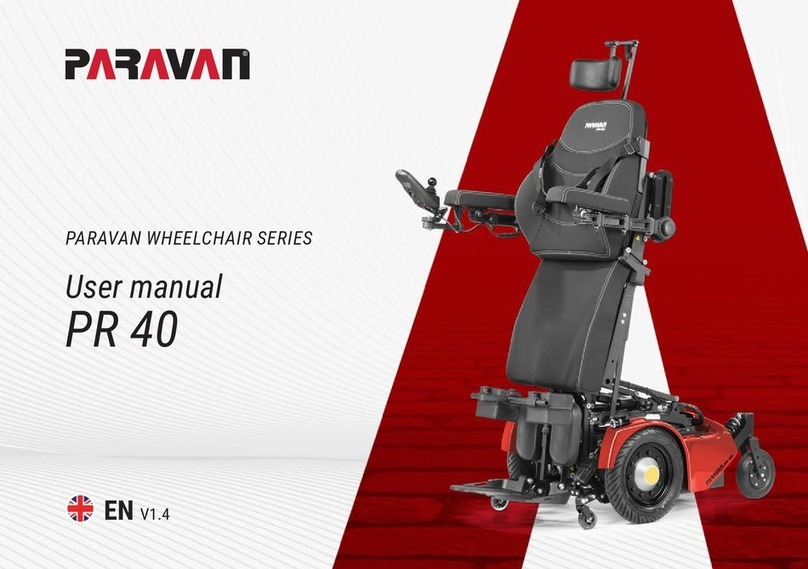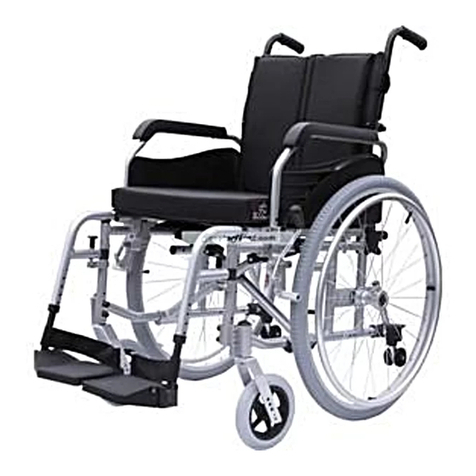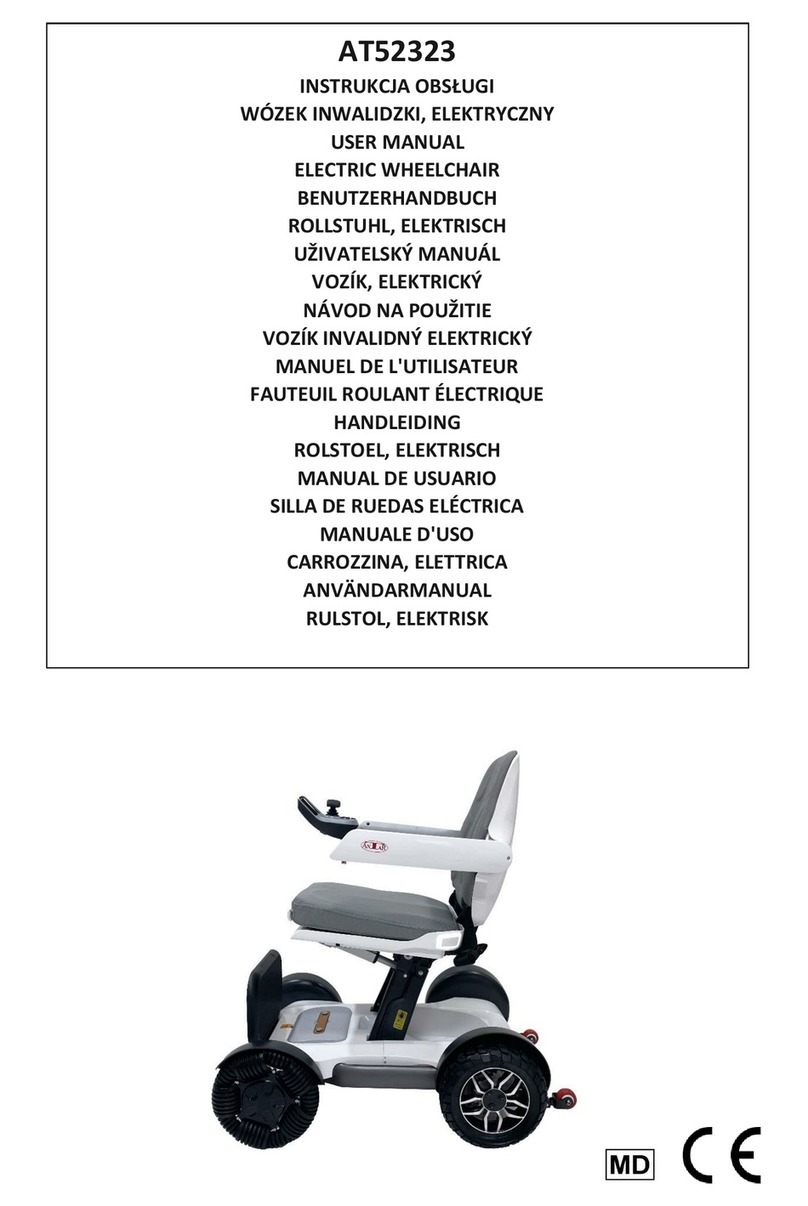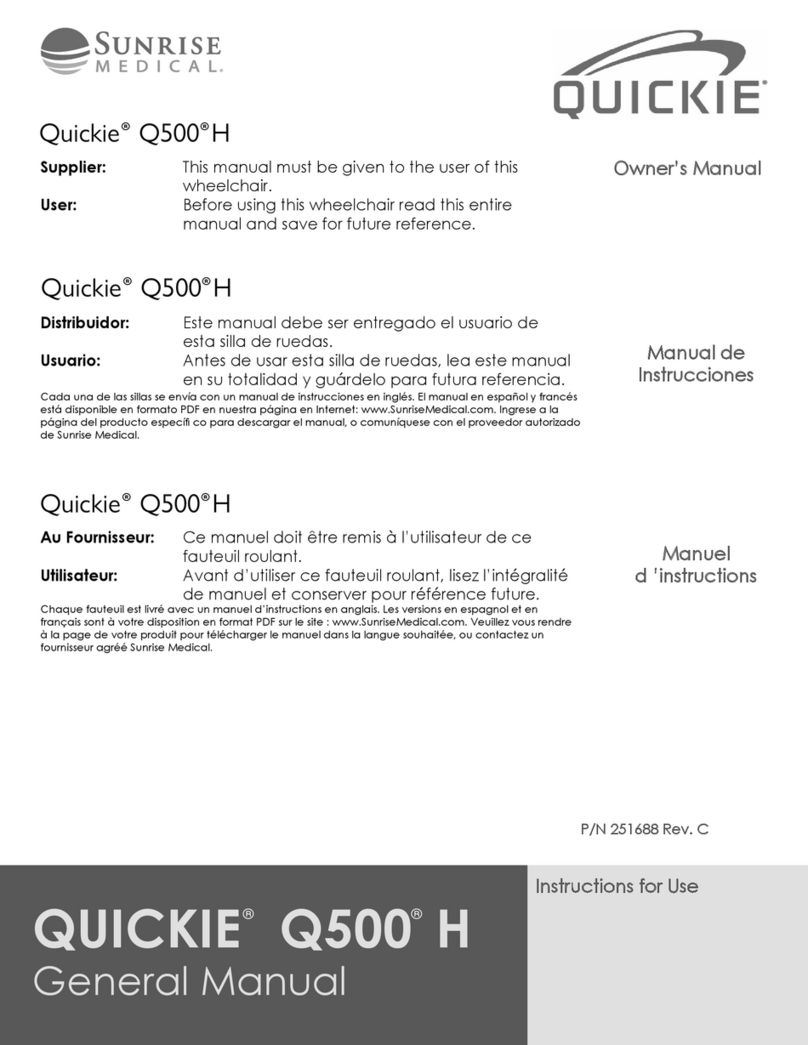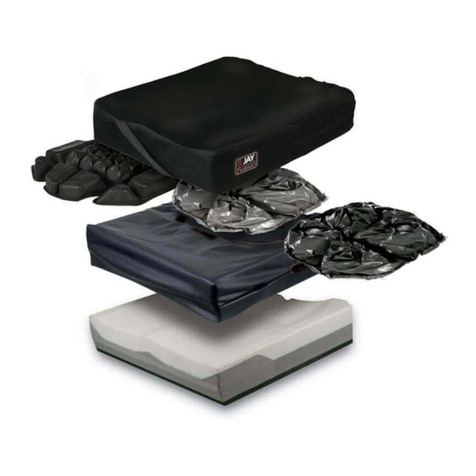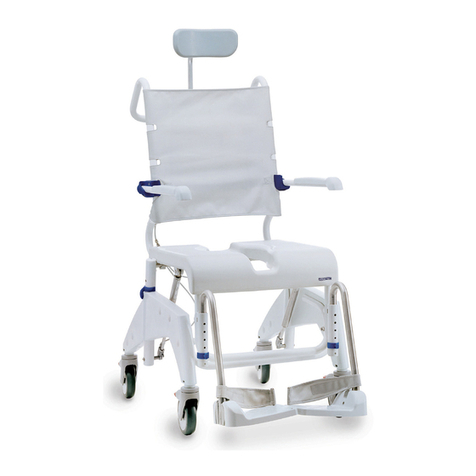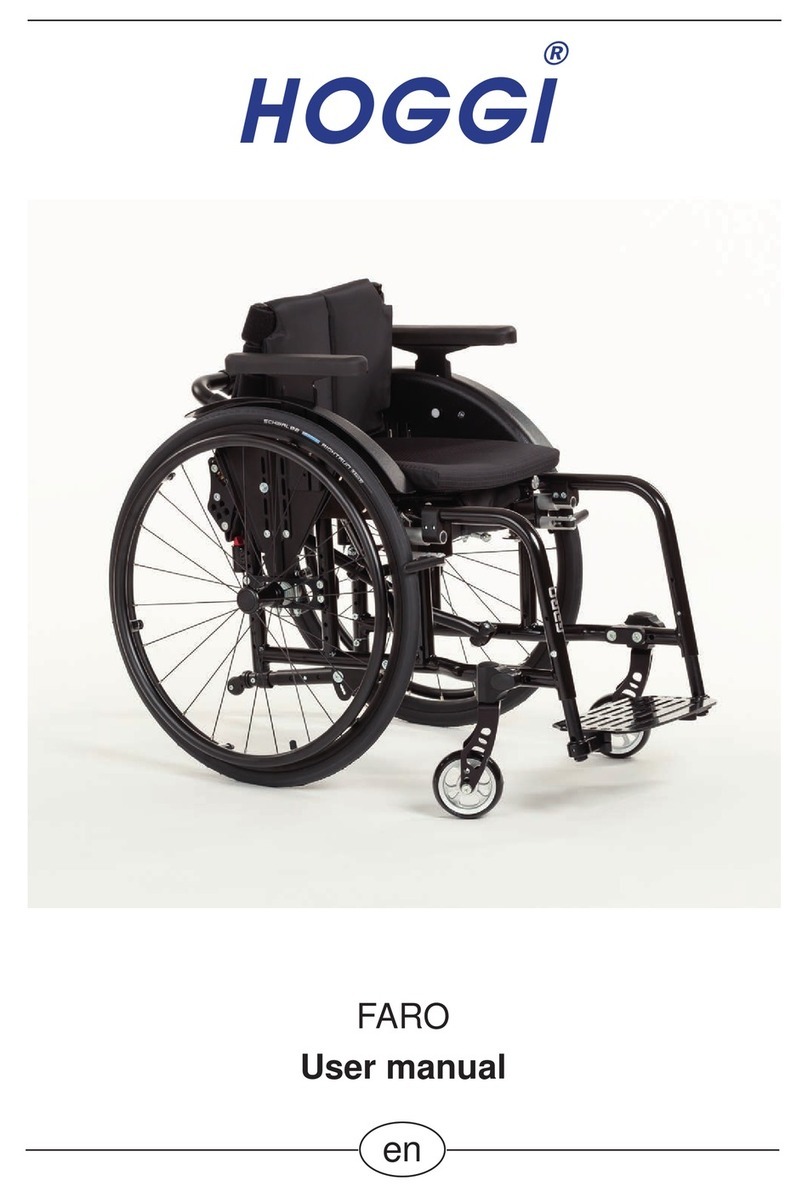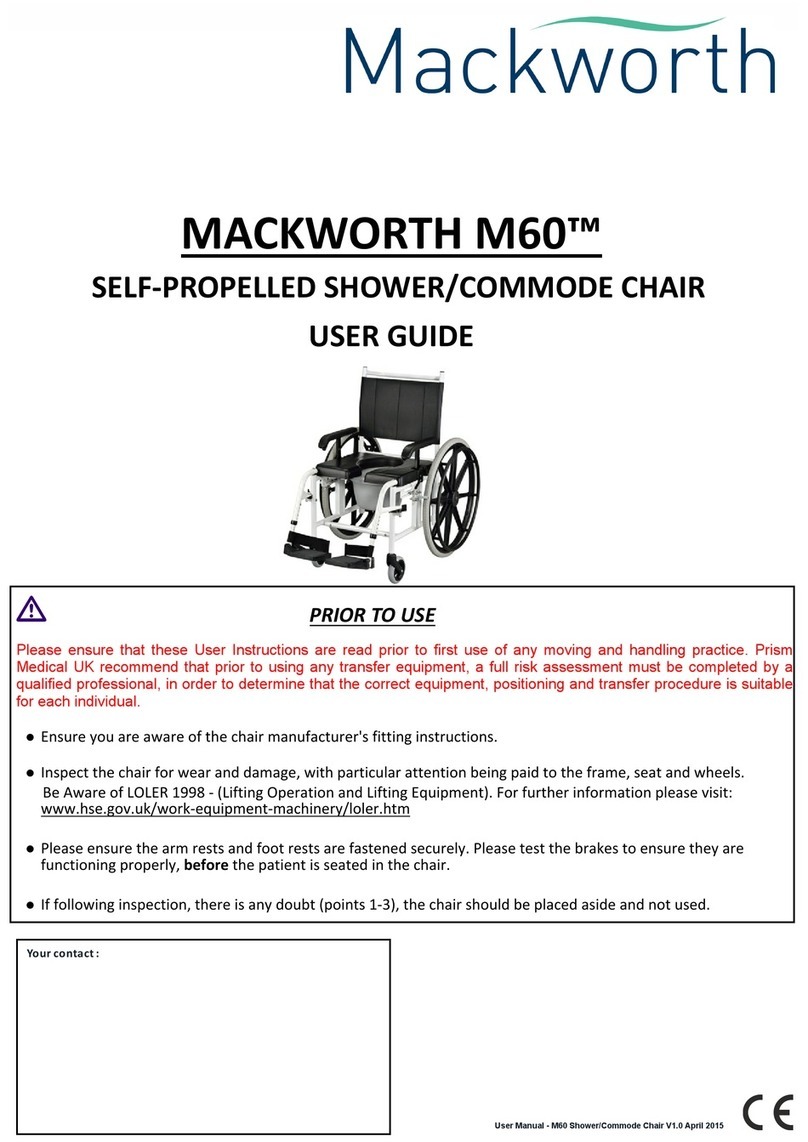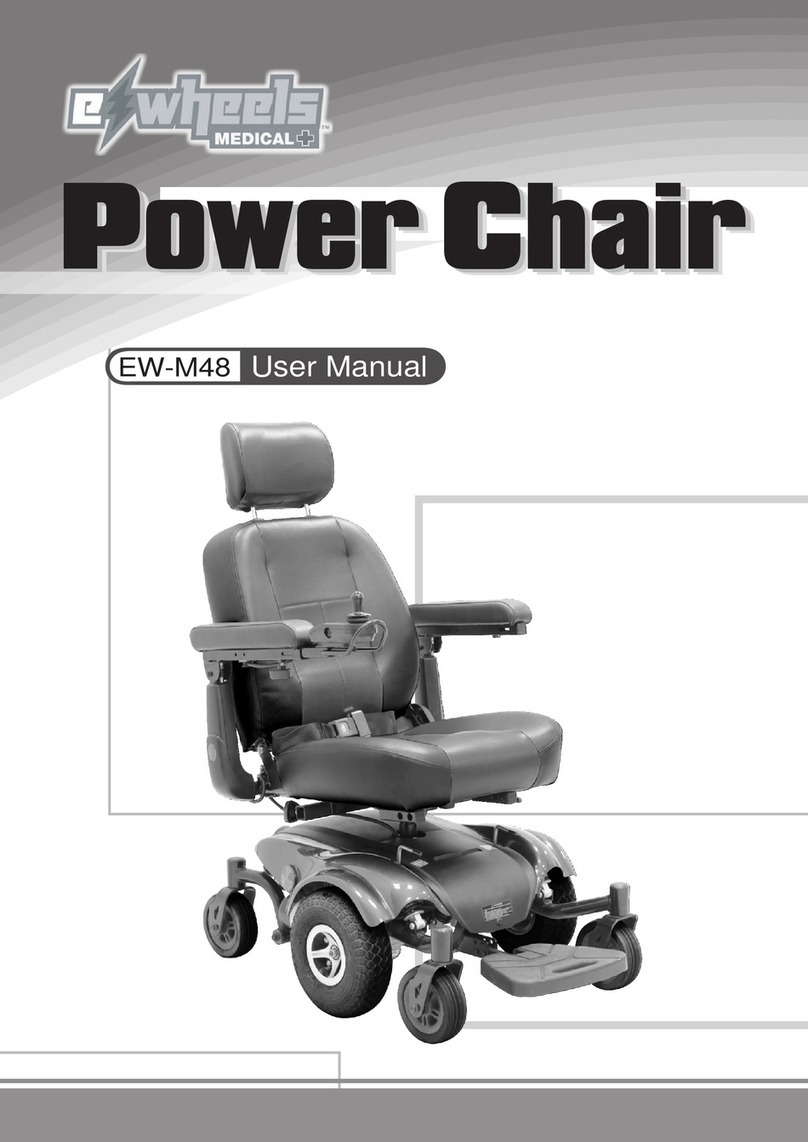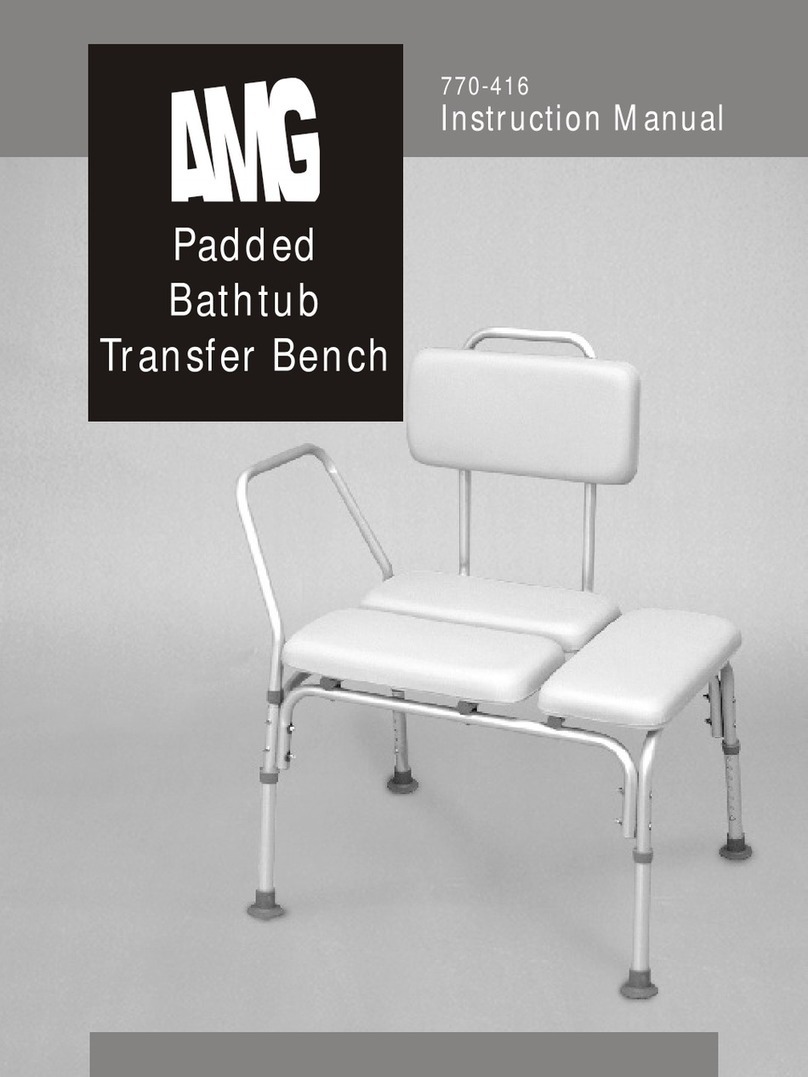Roma Medical 1232 User manual

Ultra Light Weight
Model No: 1232
USER MANUAL
Please ensure this manual is read and understood before
using the wheelchair.
Sept 11

Contents Page
Introduction 3
IntendedUse 3
Technical Specification 3
Feature Guide 4
Safety Advice 5
Opening and Folding 6
Reaching and Stretching 6 & 7
Reclining and Tilting 7 & 8
General Use / Maintenance 8 - 10
Warranty
2

Introduction
Congratulations on the purchase of your new RMA wheelchair. Extensive
research and development combined with high quality components and
stringent testing ensure that RMA wheelchairs are of the highest standards.
Our aim at RMA is to provide maximum mobility and independence to
wheelchair users. We believe that our wheelchairs offer high quality and
competitive prices, providing both comfort and safety to the user.
This user guide will help you to operate your wheelchair with confidence. It is
important to follow the safety information in this guide, taking note of the
various warnings and recommendations. Ensure that you understand these
user instructions and follow the maintenance advice given.
Your local wheelchair dealer will be able to supply you with parts and after
sales service, as an RMA supplier he will be able to assist you at all times.
Intended Use
The RMA 1232 ultra lightweight transit chair was designed to provide a
lightweight means of assisted mobility for users up to 110kgs (17st).
The folding backrest and removable footrests make it easily transportable
when not in use, and the parking brakes allow the attendant to either
gradually brake when moving down an incline or lock the rear wheels when
stationary.
Technical Specification
Length 89cm 35”
Width 63.5cm 25”
Height 91cm 36”
Seat Height 51cm 20”
Seat Depth 40cm 16”
Width Between Arms 45cm 18”
Seat to Footrest 40 – 50cm 16 – 20”
Overall Weight 11kgs 24lbs
Maximum User Weight 110 kgs 17 stone
3

Feature Guide
‘1232 – Ultra Lightweight’
1. Folding backrest for easy transport
2. Locking brakes
3. 30cm Pneumatic rear wheels
4. 20cm solid front castors
5. Swing away detachable leg rests adjustable in depth
1 2
3
4
5
4

Safety Advice
This user manual gives guide points to the most common procedures and
techniques involved in the safe operation and maintenance of your
wheelchair.
Please practice these techniques until you are competent in manoeuvring
around obstacles and feel at ease in controlling your wheelchair. The
techniques described in this booklet are a starting point for a new wheelchair
user, with safety being the prime consideration.
Use this booklet as a basic guide. Many wheelchair users successfully use
the techniques suggested on the following pages. It is also advisable that a
health care professional be involved prior to your wheelchair being operated.
ALWAYS ENSURE that the brakes are applied when entering or leaving the
wheelchair and that when travelling in a motor vehicle the wheelchair user
transfers to the motor vehicles seat and uses the safety restraints provided in
the motor vehicle.
SAFETY PRECAUTIONS
• Do not exceed the weight capacity.
• Do not attempt steep inclines unless your wheelchair is fitted with anti
tipping wheels and you have assistance.
• Do not adjust the footrests lower than 6.5 cms (2½ins) from the ground.
• Do not stand on the footplates when transferring to or from the
wheelchair. This could cause the chair to tip.
• Do not lean on the wheelchair or use it as a walking aid, this could
result in a loss of balance.
• Do not lean / reach forward unless you have ensured the castors are in
a forward position.
• Do not attempt to lift the wheelchair by the armrests or leg rests if they
are of the removable type.
• Do not replace or fit any other parts other than RMA parts to your
wheelchair.
• Do not fix any restraints to the wheels of the wheelchair.
• Ensure that the brakes are clean and adjusted correctly. Brakes can
fail if the tyres are not inflated correctly.
Never let the user ‘fall’ backwards into the seat unattended – this could lead to
instability and injury.
Removing the wheelchair from its carton
Tip the carton on to its side with the wheelchair’s pushing handles pointing to
the floor. Slightly raise the pushing handles and wheel the chair from its
carton. This procedure alleviates the need to lift the wheelchair above waist
height.
5

OPENING AND FOLDING THE WHEELCHAIR
Opening the wheelchair
Remove all outer packaging from the wheelchair.
Gently pull the arms apart and the wheelchair should
open. Push down on the sides of the seat to ensure that
the chair is fully opened.
Folding the wheelchair
The wheelchair footplates should be lifted to the vertical
position and the detachable footrests removed prior to
folding. Also fold down the backrest.
Grip the front edge of the seat upholstery and pull
upwards. The crossbars of the wheelchair will come
together closing the wheelchair.
On fold down back models, fold the backrest prior to
folding the chair.
Reaching, leaning and bending
If you find yourself having to reach lean or bend, it is
important to ensure that the front castors are used to give
extra stability. Position the front castors in a forward
position and apply the brakes.
DO NOT sit on the front of the seat and attempt to
reach for high objects. This could potentially lead to
a forward tip and injury to the user.
DO NOT attempt to pick up objects that are situated
on the floor between your legs.
ALWAYS seek assistance if there is an object
outside your reach.
6

Leaning backwards Position the wheelchair as close as
possible to the item you are trying to reach.
Do not over reach.
Do not lean over the backrest as this may cause the chair to
tip or become unstable.
DO NOT over reach backwards or sharply adjust your
body position as this may cause instability.
DO NOT stand on the footplates, this will cause the
wheelchair to tip forward. Always flip the footrests up and
use the floor.
ALWAYS seek assistance whenever you are experiencing
difficulty.
Caution
On assessment of the wheelchair user the healthcare
advisor should be able to determine the persons stability
when using a wheelchair and if necessary recommend a
wheelchair fitted with anti-tipping levers.
Reclining / Tilting (For Attendant Purposes Only)
Grip the pushing handles firmly and place a foot on the
tipping lever.
Push down on the tipping lever until the balance point is
achieved. The attendant will feel the difference in weight
ratio and can control the tilt from the push handles and
tipping levers.
Turn the wheelchair in the direction required.
Returning from the tilted position, keep one foot on the
tipping lever and a firm grip on the pushing handle and
lower slowly to the ground.
The same procedure can be adopted to lower and raise
persons up and down Kerbs.
An attendant should be available for kerb climbing.
The wheelchair should be tilted back in the manner described above.
Going up a kerb the wheelchair is pulled up and over backwards.
7

Going down the kerb the same operation is applied as
going up, lower the wheelchair slowly down the kerb
with the chair tilted back.
Ensure that when these actions are undertaken the
attendant has sufficient bodyweight to hold the
wheelchair and the user. If not please ensure that two
attendants assist.
Do not use the wheelchair on an escalator.
Do not use the wheelchair for ascending or
descending stairs.
Wheels
The large wheels should be checked at least monthly for correct axle
tightness. If the wheel is loose or wobbles tighten the axle bolt slightly. To test
for correct tightness, lean the chair to one side and spin the wheel. The wheel
should stop spinning by running down slowly. If it stops abruptly, it is too tight
and the axle should be loosened.
Castors
The castors are secured to the fork by an axle nut and bolt. This nut and bolt
should be periodically checked to allow a secure but free spinning wheel.
The castor fork swivel allows the wheelchair to turn properly. An adjustment
locknut is located under the castor cap. Pry this cap off to expose the
adjustment locknut. If the locknut is too tight the wheelchair will be difficult to
steer. If the locknut is too loose the castor will flutter and may cause the chair
to become unstable.
To check for correct tightness
Tip the chair backwards, resting the push handles on the floor.
Raise the castor wheel towards the ceiling then gently push downwards to
either side. The wheel and fork should freely swivel to the bottom of its arc
and hang straight down towards to the floor after a pendulum type swing.
If the wheel stops angled to one side, loosen the locknut on the fork stem.
Cross braces
Note! Periodically lubricate the centre bolt. This will help the chair to flex when
crossing uneven surfaces.
Brake Adjustments
On cable operated brakes there are two adjustment points release the locking
nut and screw out the cable adjuster ‘X’ until the brake arm clears the wheel
by approx. 3mm. Retighten the locking nut and repeat the process on the
other brake mechanism. With the wheels off the ground, check that they spin
freely and do not rub the brake arm when the brakes are not applied.
Adjust ‘X’ anti clockwise to tighten the brake
mechanism
8

Brake Operation
The brake can either be used as an aid to control the chair whilst travelling
down an incline or can be locked on for when the chair is stationary.
Always lock the brakes on when leaving the chair/user unattended to
avoid any incident as the chair will roll away if left on an incline with the
brakes unlocked.
To use the brake to control the chair on an incline pull the lever up into the
handle. To lock the brake, push down. The brake handle will ‘lock’ into the
lower position. To unlock the brake, simply pull upwards and the brake will
become free.
Safety Checks
Periodically under take the following inspections. The frequency of these
inspections will be determined by the amount of use the wheelchair is
subjected to.
It is suggested that your wheelchair has an annual inspection and service by
your dealer.
General
Wheelchair opens and closes smoothly
Wheelchair runs straight (no excessive drag or pull to one side)
Brakes
Brakes do not rub on the wheels when moving.
Brakes are easy to apply.
No loose linkages on the brake
Brake cables are not damaged
Cross braces
Inspect for wear or bends.
Pivot bolt is secure, but slides freely.
9

Skirt guards
Inspect for damage, broken panels or sharp edges.
Self-taping screws or rivets are secure.
Armrests
Check for damage
Ensure armpads are screwed firmly in place.
Seat and back
Check edges for tears
Check for excessive stretch.
12" & 8" wheels
No excessive side movement when wheels are spun.
Axle lock nuts are secure.
8" castor wheel bushes
Inspect stem for correct tension by spinning the castor. Castor should
come to a gradual stop. Adjust tension on lock nut if wobble persists
replace bearings.
Tyres
Inspect for wear.
Ensure tyres are inflated to the correct pressure.
Maintenance
Whenever any part of your wheelchair is not functioning properly, a hazardous
situation could result. Periodic inspection, adjustment and replacement of
worn parts will provide many years of trouble free performance.
Maintenance is best performed by a qualified RMA dealer
Upholstery cleaning
Use hand warm soapy water.
Caution! Do not use paint remover, or solvents on the upholstery.
Metal Parts
Clean all metal parts with auto wax or a similar compound.
Caution! Do not use strong detergents, abrasive cleaner or any other material
that will scratch the finish
Tyres
Periodically examine tyres for wear and replace as needed. Pneumatic tyres
should be checked weekly and kept properly inflated (see tyre side wall for
recommended inflation level). Solid tyres should be replaced when they
become loose on the rim or when they are cracked or worn.
10

11

WARRANTY TERMS AND CONDITIONS
Standard Terms
This is to certify that your RMA wheelchair is guaranteed for a period of one
year from the date of purchase. The warranty is not transferable.
If a defect or fault arises the dealer from where the product was
purchased should be notified immediately.
The manufacturer will not accept liability for damage caused by any misuse,
unauthorised alterations or non-observance of the instructions set out in this
user manual.
The guarantee excludes parts, which have been subjected to natural wear
and tear during this period (Tyres and plastic parts)
Model No:……………………………
Serial No:…………………………….
Purchase Date:……………………..
RMA Ltd,
York Road,
Bridgend Industrial Estate,
Bridgend.
CF31 3TB
Tel: 01656 674488 Fax: 01656 674499
www.romamedical.co.uk
RMA reserve the right to change specifications without prior notice
Dealer’s Stamp
KB&S16101
Table of contents
Other Roma Medical Wheelchair manuals

Roma Medical
Roma Medical Shoprider User manual

Roma Medical
Roma Medical sirocco p110 User manual

Roma Medical
Roma Medical 1500 User manual

Roma Medical
Roma Medical Marbella P200 User manual

Roma Medical
Roma Medical Reno Elite P325 User manual

Roma Medical
Roma Medical 1300 User manual

Roma Medical
Roma Medical 1415 Self Propel Wheelchair User manual

Roma Medical
Roma Medical 1823 User manual

Roma Medical
Roma Medical Reno II P319 User manual

Roma Medical
Roma Medical P001 User manual


